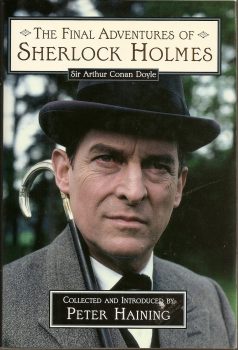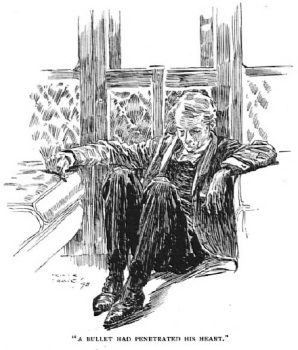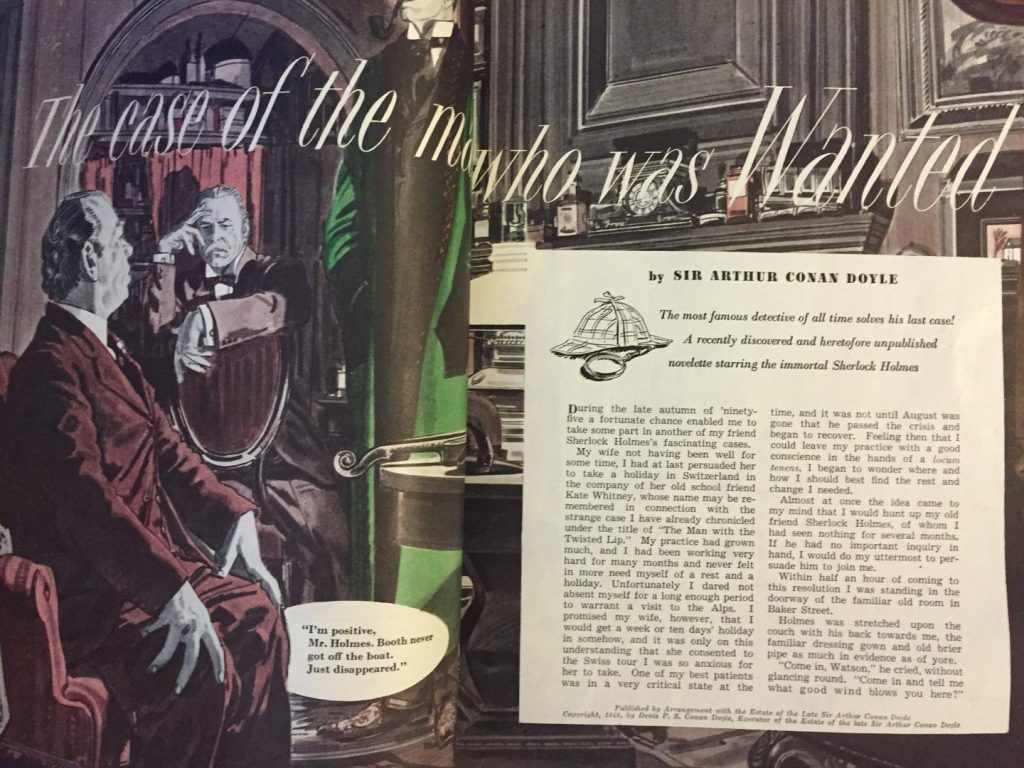The Public Life of Sherlock Holmes: The Final Adventures of Sherlock Holmes (Haining)
 Peter Haining was a notable Sherlockian who compiled/edited several useful Sherlock Holmes books.
Peter Haining was a notable Sherlockian who compiled/edited several useful Sherlock Holmes books.
Back around 2005 or so, an article in the Wall Street Journal was about Barnes & Noble’s in-house publishing imprint. They have been reproducing classic works for years and selling them at affordable prices. But they range father afield than that, and my Sherlockian bookshelf includes several of their titles, such as The Sherlock Holmes Companion, The Lost Adventures of Sherlock Holmes and The Final Adventures of Sherlock Holmes.
The latter was the main source for the Doyle on Holmes series. The Final Adventures of Sherlock Holmes is a collection of stories, plays, and essays about Holmes that are not part of the Canon but certainly make nice supplementary reading. An excellent addition to any Holmes library.
It is somewhat similar to the out-of-print and often difficult to find Sherlock Holmes: The Published Apocrypha by Jack Tracy. Both books include the “almost Sherlock Holmes” stories and plays that don’t fit in the Canon, but are certainly in the neighborhood. I wrote about that one, here.
The introduction discusses the pieces that make up the book and you will find some interesting tidbits (much of which was previously in Tracy’s book).
The book starts off nicely with The Truth About Sherlock Holmes, which is an essay by Doyle that appeared in Colliers in 1923. Much of this essay would find its way into Doyle’s own autobiography, Memories and Adventures. It is a very interesting essay and worth reading by all Sherlockians. Being a dedicated reader of this column, you read my essay on that one, earlier this month.
“The Mystery of Uncle Jeremy’s Household” appeared in Boy’s Own Journal in early 1887, after A Study in Scarlet was written, but before the first Holmes novel was published. I would suggest reading this story and amusing yourself by listing the Holmesian overtones. You will find more than one!
Next up is “The Field Bazaar,” one of Doyle’s two short-short-shorts which he wrote about Holmes. It recounts a breakfast conversation between Holmes and Watson and was written as a fundraiser for the student newspaper at Edinburgh University.
 Two tales from 1898 follow. “The Story of the Man With the Watches” and “The Story of the Lost Special” both feature an unnamed detective and are quite Sherlock Holmes-like in their feel. Either of these books could easily have been written as Holmes adventures, or even transformed into Solar Pons tales. While not Doyle’s best detective stories, they are better than some of the official tales from the Canon. Since they were published after the detective’s supposed death and before his return, was Doyle just “getting some Holmes” out of his system?
Two tales from 1898 follow. “The Story of the Man With the Watches” and “The Story of the Lost Special” both feature an unnamed detective and are quite Sherlock Holmes-like in their feel. Either of these books could easily have been written as Holmes adventures, or even transformed into Solar Pons tales. While not Doyle’s best detective stories, they are better than some of the official tales from the Canon. Since they were published after the detective’s supposed death and before his return, was Doyle just “getting some Holmes” out of his system?
Hesketh Pearson was researching a biography of Doyle when he found the outline of an unwritten Holmes story, and a completed Holmes tale, The Case of the Man Who Was Wanted (mentioned below). The outline is included here. It is immediately followed by a completed version of the tale, written by Robert A. Cutter, in 1947. It is titled “The Adventure of the Tall Man.”
I’m quite a fan of William Gillette’s marvelous play, Sherlock Holmes. However, his adventure into the parody world, the curtain raiser The Painful Predicament of Sherlock Holmes, is not one of my favorites. The novelty of Holmes not uttering a single word is original, but I just don’t find the play very funny.
For “The Case of the Man Who Was Wanted,” I have included the contents of my review of Tracy’s Apocrypha:
Pearson also discovered an entire previously unknown Sherlock Holmes tale in 1942. The Doyle estate (always quick to try and make a buck) surprisingly enough resisted pressure to publish it. Finally, in 1948, they accepted an offer from Cosmopolitan and it was published. Then the bad news: Arthur Whitaker said that he had written the tale and sent it to Doyle in 1910, hoping it would become a collaboration. Doyle declined and suggested Whitaker rewrite is as non-Holmes tale. Finally, Doyle purchased it for 10 pounds. Doyle set it aside, never using it. Whitaker produced the carbon copy of his typescript, as well as Doyle’s own hand-written letter in which the author had offered to buy the script.
The Doyle Estate refunded some of the money they received for selling the story and Whitaker was paid 150 pounds to be quiet about the affair. He died not long after and the matter was dropped by all parties. Cosmopolitan never admitted the story wasn’t by Doyle, and the Estate had no comments.
Haining’s explanation includes the following quote from Pearson’s description of the story. “The opening scene between Holmes and Watson betrays the hand of the master.” Haining also mentions a reference to the story made in John Dickson Carr’s biography of Sir Arthur. Haining speculates that Doyle himself may have contributed somewhat to the tale and that it was not all Whitaker’s work. Regardless, it is an enjoyable Holmes pastiche.
The late Jon Lellenberg’s Nova 57 Minor is a must-read about the entire affair.
Some Personalia About Sherlock Holmes was written by Doyle and appeared in a 1917 edition of The Strand. You know all about it, since you read my essay three weeks ago… Doyle discusses receiving letters written to Holmes and ruminates on true life crimes that the author had some involvement in investigating. One such, involving a man who disappeared, I wrote as a story involving Doyle and William Gillette. It was published as “The Case of the Tired Captain” in a collection entitled Curious Incidents. You can read it here.
American critic Arthur Guitterman wrote a poem critical of Doyle for having Holmes insult Edgar Allen Poe’s C. August Dupin, and Emile Gaboriau’s Monsieur Lecoq, in A Study in Scarlet. It is included here, followed by Doyle’s own poem in response. People were taking the Canon far too seriously long before Sherlockians jumped into the act. Yep – wrote about that two weeks ago.
Doyle’s short Holmes play, The Crown Diamond, is next. It is a weak story and quite inferior to his play adaptation of The Speckled Band.
How Watson Learned the Trick is a charming mini-parody written by Doyle for inclusion in the miniature library in a dollhouse made for Queen Anne. I find this to be a greatly underappreciated Holmes piece and is one of my favorites. I wrote my own version of it as a Christmas story.
On December 15, 1900, A Gaudy Death: Conan Doyle Tells the True Story of Sherlock Holmes’ End appeared in Tit-Bits, a weekly magazine published by the same folks who owned The Strand. Holmes was in that unhappy (for the readers) period after his plunge at the Reichenbach Falls and before his temporary revival in The Hound of the Baskervilles. This is a fine interview in which Doyle discusses how he came up with the idea for Holmes, and why he switched from novels to serial adventures for the detective. He then moves on to explain why he killed off Holmes. “My lower work” (Holmes) “was obscuring my higher” (The White Company) “is as good a summary of his feelings as ever he uttered.
It’s hard for us to imagine a Canon that ended with The Memoirs. A paltry 26 Sherlock Holmes adventures! So imagine the thrill that the discerning reader of this essay experienced at the following sentence from Doyle: “That does not say, however, that because he is dead I should not write about him again if I wanted to.” I get a tingle myself! I wrote about that essay too.
“The Mystery of Sasassa Valley” was Doyle’s first published story and is a tale with a supernatural tinge.
The volume wraps up with My Favourite Sherlock Holmes Adventures, a short piece Doyle wrote for The Strand in 1927. It is a listing of Doyle’s own dozen favorite Holmes tales. He does not include any from The Case-Book, which was about to be published in book form and had not been readily available to most readers.
I like to believe that his statement that he would have included “The Lion’s Mane” and “The Illustrious Client” on the list if they were eligible was a selling job. I can’t place those two anywhere near the top twelve. Last week’s post was on that essay.
Peter Haining’s book is an outstanding collection that any Holmes fan should enjoy. If you already have Tracy’s The Published Apocrypha, or vice versa, you will find they complement each other and you shouldn’t ignore one because you own the other.
DOYLE ON HOLMES
Some Truths About Sherlock Holmes
Some Personalia About Sherlock Holmes
A Gaudy Death
The Case of the Inferior Sleuth
Doyle’s Favorite Sherlock Holmes Adventure

Bob Byrne’s ‘A (Black) Gat in the Hand’ made its Black Gate debut in 2018 and has returned every summer since.
His ‘The Public Life of Sherlock Holmes’ column ran every Monday morning at Black Gate from March, 2014 through March, 2017. And he irregularly posts on Rex Stout’s gargantuan detective in ‘Nero Wolfe’s Brownstone.’ He is a member of the Praed Street Irregulars, founded www.SolarPons.com (the only website dedicated to the ‘Sherlock Holmes of Praed Street’) and blogs about Holmes and other mystery matters at Almost Holmes.
He organized Black Gate’s award-nominated ‘Discovering Robert E. Howard’ series, as well as the award-winning ‘Hither Came Conan’ series. Which is now part of THE DEFINITIVE guide to Conan. He also organized 2023’s ‘Talking Tolkien.’
He has contributed stories to The MX Book of New Sherlock Holmes Stories – Parts III, IV, V, VI, XXI, and XXXIII.
He has written introductions for Steeger Books, and appeared in several magazines, including Black Mask, Sherlock Holmes Mystery Magazine, The Strand Magazine, and Sherlock Magazine.

B&N’s publishing always did seem to be good quality, and tending a bit to the academical. Good to know that that held up with Peter Haining’s collection! I think I may have their version of the Kalevala, and if so, that has a very dense and informative introduction. Do you think that Haining’s introduction to his book deliberately borrowed from Tracy’s, or were they just working from the same time-limited source materials?
(Side Note: The “Scotland Unplugged” YouTube channel recently made a trip to several ACD-related sites and has released a short video on Joseph Bell titled “Meet the Real Sherlock Holmes.” It probably contains nothing new to you, but it may be fun to hear some of the material you already know spoken in a Scottish accent.)
Haining did so much Holmes stuff, I assume he wasn’t overly influenced by anyone. Between this and Tracy’s Apocrypha, there’s sure some neat reading!
Thanks for the youtube tip. There’s a Scottish guy that reads Robert E. Howard stories and poems on youtube. I LOVE his accent!!!!